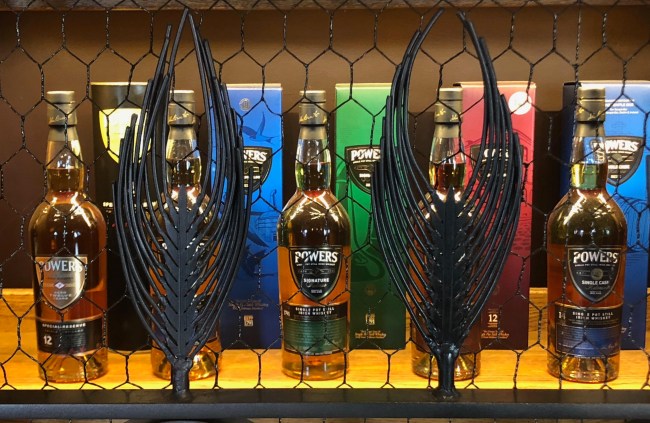
Brobible
Presented by Powers Irish Whiskey, all thoughts our own. Enjoy Powers responsibly, 21+
I’ve been in a serious relationship with whiskey for the better part of the last decade, and based on how much time we’ve spent together, I like to think I know it pretty well.
However, I also have a crippling case of imposter syndrome, so to give myself some reassurance, I recently decided to do a deep dive into the spirit to make it a little easier for myself (and others) to navigate the complex world of whiskey.
Before I started researching, I had kind of assumed the Scottish were responsible for introducing the world to whiskey but quickly discovered that was not the case.
Long before they were peating barley in the Highlands, monks in Ireland were distilling their own version of whiskey (although it would take a while before their unaged spirit would evolve into what we know it as today).
In fact, “whiskey” is an Irish word taken from the Gaelic term “uisce beatha,” meaning “water of life,” (which is itself a translation of the Latin phrase “aqua vitae” if you happen to be craving even more etymology).
I’ll admit my exposure to Irish whiskey is— or, as you’ll soon see, was— limited largely to taking shots of it at happy hour and the occasional visit to Dead Rabbit in New York City, where the bartenders were more than happy to help me wander out of my comfort zone. It was there that an Irish native helping me navigate the menu turned me on to Powers, his go-to option and (if he was to be believed) the whiskey of choice in Ireland for centuries.
I recently learned he was, in fact, to be believed after getting a chance to visit Ireland courtesy of Powers itself, which invited me to tour the country for a few days and experience their whiskey in its natural environment. I documented most of my trip last week but there was one aspect of the journey I only touched on: the whiskey itself.

Brobible
Tucked between a dip into the frigid waters of the Dublin Bay and a crawl of the city’s pubs was a trip to Midleton, a town nestled in County Cork. It was there that I got the full Powers experience by spending the day at its distillery to take an immersive look at how the whiskey is made and, perhaps more notably, how it came to be.
After being greeted with a bathing suit and a towel the previous morning, I was relieved to see the only thing waiting for me when I arrived in Midleton was whiskey.
There were three glasses laid out on the table in front of me, each of which contained a sufficiently small amount of unaged whiskey (which, for the uninitiated, is essentially moonshine and one hell of a way to wake yourself up).
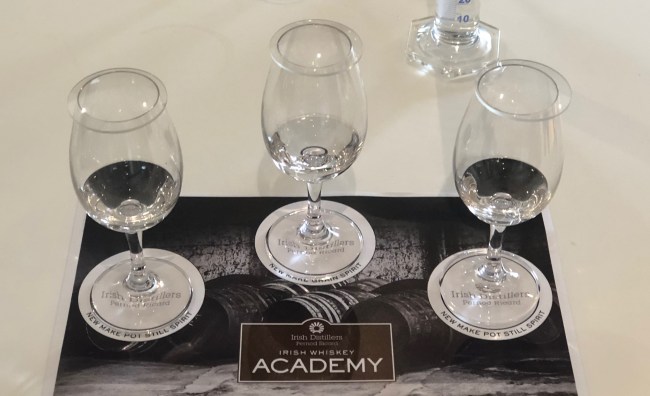
Brobible
I got to sample three different distillates used as a base for various pot still whiskeys, and while all three variants had their own unique taste, “alcohol” was the overwhelming flavor note.
Thankfully, the same couldn’t be said for their matured counterparts, each of which showcased how different woods and aging times impact the final flavor and color of the product.
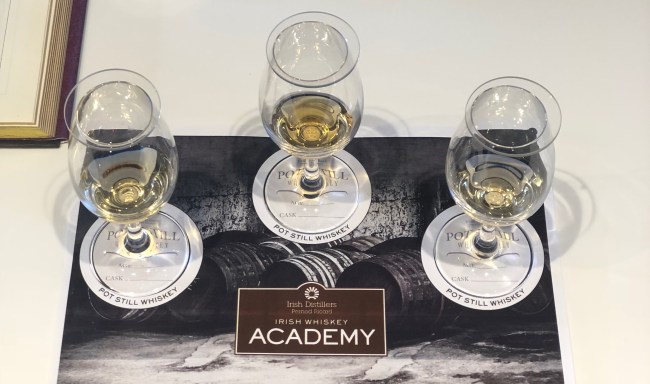
Brobible
It was a day that would be steeped in history and the first lesson came courtesy of Alfred Barnard, a historian who documented his drink-inspired travels in the impressive volume The Whisky Distilleries of the United Kingdom.
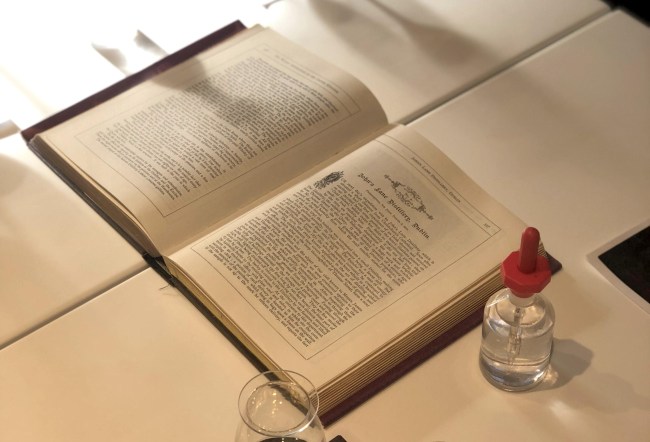
Brobible
The book contains detailed accounts and illustrations of the 162 producers Barnard visited over the course of a two-year journey in the 1800s, including a recounting of his visit to the former site of the Powers distillery in Dublin. Barnard was equally in awe of its size and efficiency as he was with the end product, declaring Powers the best whiskey he’d tasted during his travels.
After the first of the day’s many tastings, I got the chance to tour the Midleton Distillery. It’s a sprawling compound dotted with stone buildings dating back to the 1700s that once housed a massive wool factory before it began producing whiskey in the 19th century.
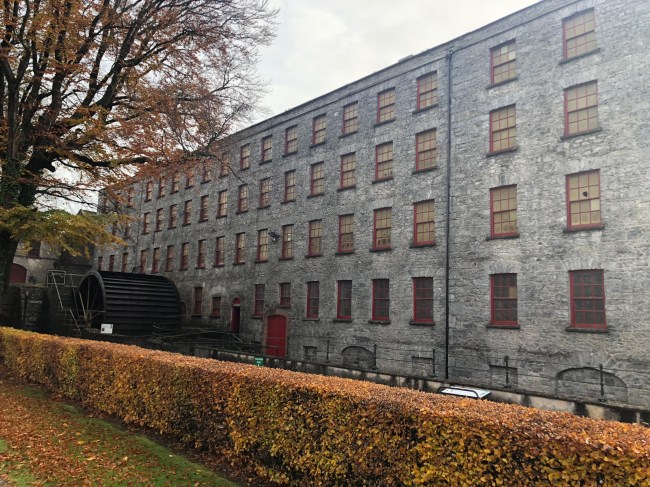
Brobible
Midleton has been home to Powers since it left Dublin in the 1970s after forming an alliance with two other distillers in an attempt to revive the Irish whiskey industry as a whole (a bold move that played a major role in its eventual resurgence).
If you’re ever on Jeopardy! and happen to be asked about the location of the world’s biggest pot still, you’ll find the answer in Midleton (the still is no longer in use but continues to hang onto the record).
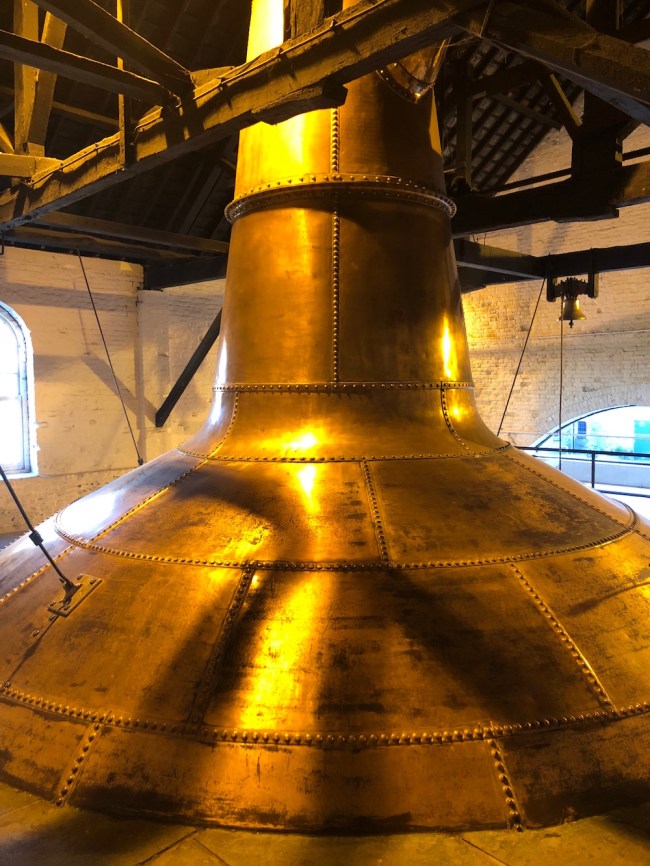
Brobible
After the first of the day’s many tastings, I got the chance to tour the Midleton Distillery. It’s a sprawling compound dotted with stone buildings dating to the 1700s that once housed a massive wool factory before it began producing whiskey in the 19th century.
I eventually ended up at the cottage Midleton’s master distiller once called home, which now houses a massive archive of Powers artifacts under the supervision of the infinitely knowledgeable Carol Quinn.
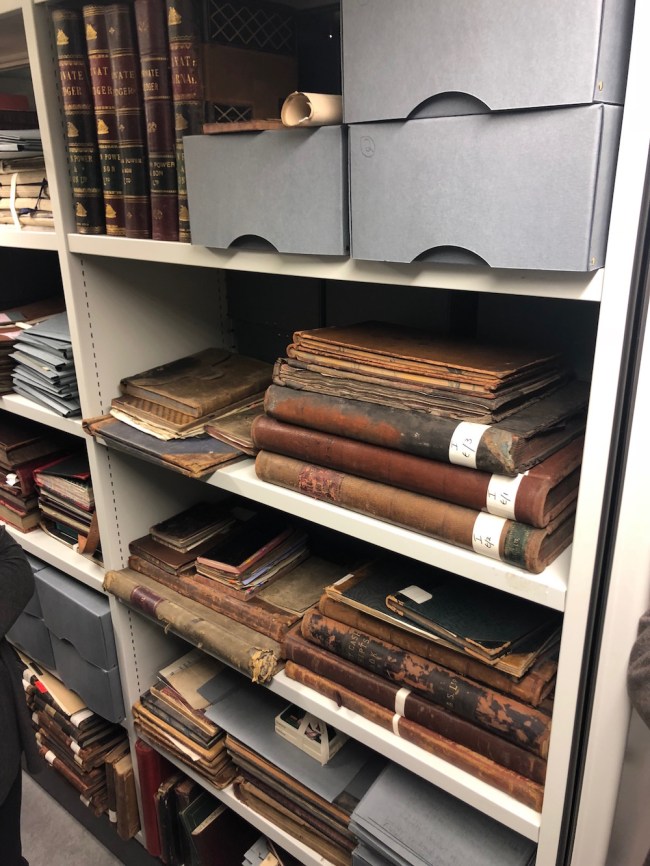
Brobible
Quinn had taken the time to assemble a number of relics aging back to the early days of Powers to serve as a visual guide as she traced the path the distillery took on its way to eventually becoming the best-selling whiskey in Ireland.

Brobible
It all begins with James Power, who started a small distilling operation at a pub in Dublin all the way back in 1791. His namesake brand would soon outgrow its original home and Powers eventually opened a facility just a short walk away off of John’s Lane, which would lend its name to the distillery that would become the industrial marvel that blew Barnard away upon his visit.
Quinn showcased a wide variety of antiques, including customized cards that accompanied bottles of Powers when they were shipped around the world, each one bearing the name of their final destination.

Brobible
There were also a number of older bottles on display, and while one was noticeably more diminutive than the others, it was perhaps the most significant.
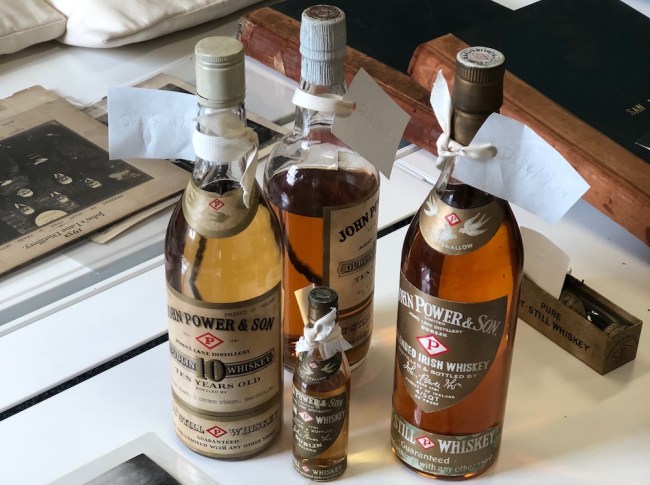
Brobible
Quinn explained that in 1889, Powers was the first distiller to ever package its product in a hand-sized bottle (which came with its own mini corkscrew). In doing so, it made their whiskey more accessible to the lower class and led other companies to follow in its footsteps, helping to blaze a path toward the nips we hold dear in our hearts today.
John’s Lane Distillery would eventually come to occupy a seven-acre area in Dublin thanks in no small part to the multigenerational efforts of the Power family, which employed 300 people at the company’s peak.
Perhaps the most notable takeaway of this trek through history was how they treated the people who staffed the distillery, especially when you consider the abhorrent working conditions many were forced to endure during the early 1900s.
In addition to free whiskey before and after shifts, the Powers offered staff affordable housing in Dublin and supplied them with multiple sets of clothes that were laundered weekly to help reduce the stigma that came with wearing worn and dirty outfits.
Many of these hired hands were farmers who were shepherded from the countryside to work at the distillery during the winter season to provide them with a supplementary source of income. Once a year, production ceased and the laborers were transported to the Power estate in the Irish countryside, where the family would host and serve on them hand and foot over the course of a day filled with leisure.
By the start of the 20th century, Powers— and the Irish whiskey industry as a whole— seemed to be an unstoppable force but they would eventually meet an immovable object in the form of American Prohibition.
While the decrease in exports didn’t do them any favors, the stellar reputation of the country’s signature spirit was also a major factor in its downfall. Bootleggers were quick to market their subpar wares as “Irish whiskey” in an attempt to take advantage of the perceived prestige and American consumers came to associate Ireland with rotgut.
By 1966, Powers was only one of two operational distilleries in Ireland and it would take decades for the industry to recover— an effort that is still ongoing.
If a visit to it’s current distillery is any indication, Powers is well on its way to regaining what it may have lost. The modern facilities dwarf the former base of the Midleton operation and are home to a number of massive stills, including the requisite copper pots and columns spanning multiple stories, all of which pump out the precious nectar that will one day become the whiskey we know and love.
Of course, to reach that point, the distillate must undergo a transformation as dramatic as the shy girl in a teen movie, which it does by sitting in barrels for at least three years before emerging as a beautiful, delicious butterfly.
I got the chance to visit one of the buildings where the casks are stored, which was kind of like the warehouse at the end of Raiders of the Lost Ark if all of the precious artifacts were replaced with barrels of whiskey, which are arguably more valuable.
While there, I tasted some liquid straight from the barrel and received a nice punch in the palate in the process before finally getting the chance to sit down and taste the fruits of the distillery’s labor.
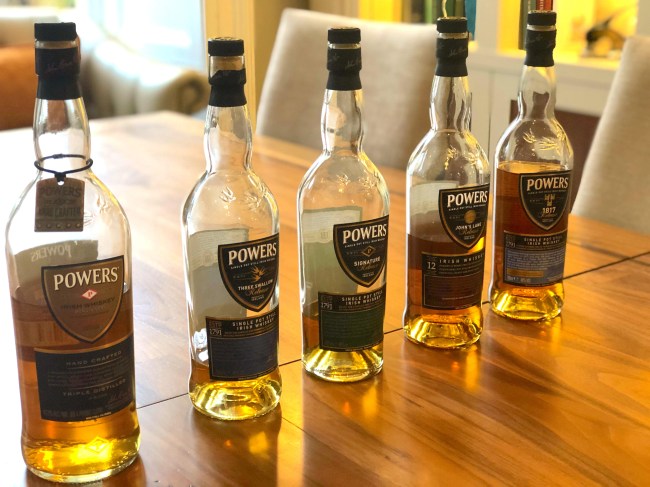
Brobible
If you’re looking for a recap, you’re in luck.
Powers Gold Label
James Power took it upon himself to set the gold standard for Irish whiskey when he first began distilling and did exactly that, turning a side hustle into an empire over the course of a few decades. However, Powers was just getting started.
In 1886, the company made the virtually unprecedented move to cut out the middlemen traditionally responsible for bottling whiskey (more than a few of whom had a tendency to tamper with the goods before packaging) and created the self-distributed Powers Gold Label in an effort to establish itself as the premium Irish whiskey.
The bottle’s trademark label— which was originally colored with ink made from ground bronze— called out from shelves and served as a testament to its pedigree. It was the whiskey the everyday man turned to when splurging at the end of the month knowing what awaited them inside justified the extra expense.
Powers’ flagship is a blended whiskey aged in used American oak barrels, a smooth, slightly spicy sipper with honey notes giving it the sweet twinge you’d expect to find in an Irish whiskey. It was, as my bartending friend informed me, the best-selling whiskey in Ireland for ages and I highly recommend giving it a try so you can see why.
Powers Signature
If Gold Label is Powers’ entry-level whiskey then Signature is the equivalent of the slightly more advanced class you take from the professor all your friends can’t stop raving about.
As is the case with all of the following offerings, Powers Signature is a single pot still whiskey, which means it’s made with malted and unmalted barley distilled entirely in Midleton. It’s also aged in used oak, but unlike Gold Label, it contains some whiskey aged in Spanish sherry casks as well.
The resulting product is a comparatively spicier whiskey, with the honey balanced out by some slightly darker notes including raisin and cinnamon. It has a slight burn to it, so while you can certainly drink it straight, I preferred it after adding a few drops of water to open things up a bit.
However, as is the case with all of these, you should enjoy it as you please (although I’d advise against mixing any of them with copious amounts of ginger ale).
Powers Three Swallow
The world has changed ever-so-slightly since 1791 and so has Powers, which has evolved with tastes and times. The Gold Label you drink today isn’t what was coming out of Dublin when it was first bottled, but if you want to get an idea of what people were sipping back then, Three Swallow is here to help you do exactly that.
Three birds adorn the label but the name itself doesn’t have any ornithological roots. It’s actually a reference to the stagecoach hands who climbed aboard carriages in trios with a few swallows of whiskey in tow— just enough to keep them warm without interfering with their ability to perform their duties.
Three Swallow is aged in specially-selected former bourbon barrels before a small amount of the aforementioned sherried whiskey joins the party. As a result, it’s similar in taste to Powers Signature but I found it to be a bit fruitier and a slightly more delicate on the palate.
It was initially only available in Ireland but has recently made its way over to the United States and I can safely say we are very lucky to have it as a guest in our country and would like to invite it to stay for as long as it pleases.
Powers John’s Lane
Taking its name from the former site of the Dublin distillery, Powers John’s Lane is a fitting tribute to multiple centuries of history and one of the finest whiskeys— Irish or otherwise— that this tongue has ever tasted.
Like Three Swallow, the whiskey is a throwback to the Powers of the past and the distillate is designed to resemble the liquid that was being barreled back in the day. However, John’s Lane is aged for a minimum of 12 years to create a criminally smooth product featuring prominent (but not overwhelming) vanilla notes.
This was my whiskey of choice when I was in Ireland, and thanks to the multiple bottles I picked up at duty-free, it will remain that way depending on how much self-control I have.
Powers 1817
Powers 1817 was introduced last year to celebrate the 200th birthday of the Licensed Vintners Association, an organization that was established in (shocker) 1817 to represent the interests of pubs in Dublin.
1817 is a ten-year-old whiskey bottled at 46% ABV (for comparison, Gold Label is brought down to 40% once it leaves the barrel) and consequently has more of a bite than any of the other variations I tried.
Every Powers I sampled was a bit spicier than the Irish whiskeys I was accustomed to but none of them came close to matching that of the 1817, which had a pleasant kick to complement the vanilla and caramel notes that faded to a smooth, slightly oaky finish.
If you want to get your hands on some, I have a bit of bad news. While all of Powers’ other offerings are available in America, these bottles were exclusively produced for drinking establishments in the city (although there were rumors a couple of bottle shops had it in stock).
Most financial planners would frown upon purchasing a plane ticket just to try a whiskey, but if you happen to find yourself in Dublin, it’s worth seeking out.
I doubt James Power knew his product would eventually become the whiskey of choice for multiple generations of Irish people and the fact that Powers is still going strong after more than 225 years says more about the distillery than I ever can (but I appreciate you reading nonetheless).
America is filled with bars offering an “authentic” Irish experience, but if you’re looking for a true taste of the culture, it’s hard to go wrong with the whiskey that has a legacy stretching back to a time when the United States was going through adolescence.
I left Ireland with a lot more knowledge (and whiskey) than I arrived with, but if you’re as ignorant about the country’s whiskey as I was before this trip and are looking to expand your horizons, I’ll give you the same advice the Irishman behind the bar at Dead Rabbit gave me: try the Powers.